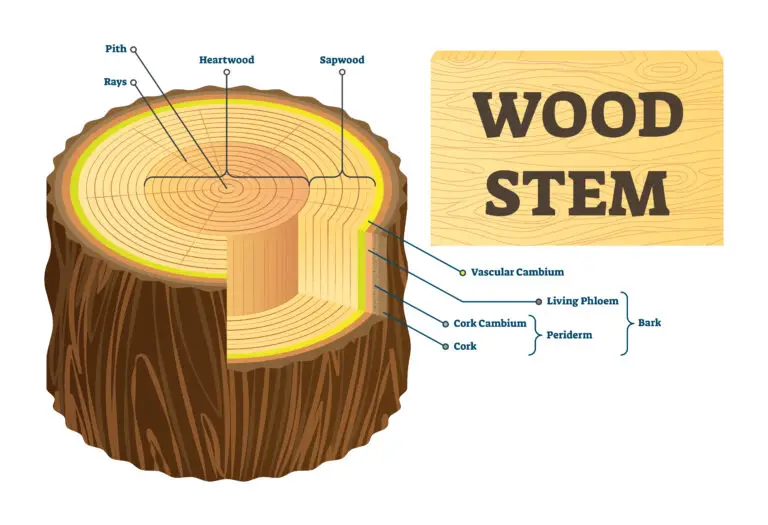Cambium

Table of Contents
What is Cambium?
Cambium is a layer of meristematic tissue in plants responsible for producing new cells and growth in vascular plants. A lateral meristem facilitates the growth in diameter or girth of plant structures, such as stems and roots. Cambium is crucial for secondary growth, leading to the development of wood in stems and roots.
Cambium Tissue Overview
Types of Cambium
- Vascular Cambium: Found between the xylem and phloem in the stems and roots of vascular plants. It produces secondary xylem (wood) towards the inside and secondary phloem towards the outside.
- Cork Cambium (Phellogen): Found in the outer layers of the stem and root, producing cork cells that make up the outer bark. Cork cambium is responsible for the increase in girth of stems and roots.
Cambium Functions
- Vascular Cambium: Produces secondary xylem and phloem, contributing to the growth in thickness of stems and roots. Secondary xylem forms wood, providing structural support and transporting water and minerals.
- Cork Cambium: Produces cork cells, which replace the epidermis in older stems and roots. Cork cells are impervious to water and protect the plant from external elements.
Secondary Growth
Secondary growth is a process in woody plants that increases their girth or thickness, as opposed to primary growth, which extends the length of the plant. This process is crucial for developing wood and bark, and it occurs in species with a cambium layer.
The cambium is a layer of actively dividing cells between the wood (xylem) and the bark (phloem) in the stems and roots of woody plants. There are two types of cambium involved in secondary growth: vascular cambium and cork cambium (phellogen).
The vascular cambium is responsible for adding layers of vascular tissue. It produces new xylem (wood) inside and new phloem cells outside. As the xylem accumulates, it forms the bulk of the woody stem and provides support and water conduction. The phloem, being more exterior, helps transport nutrients throughout the plant.
The cork cambium produces cork (phellem) cells outside, which replace the epidermis and form the protective outer bark. This layer helps to insulate and protect the plant from physical damage and disease.
Cell Division
The cambium cells divide actively through mitosis, which is the process where a single cell divides to produce two identical daughter cells, and cytokinesis, where the cell’s cytoplasm divides, creating two distinct cells. This division occurs in the cambium layer between the established xylem (wood) and phloem (part of the bark).
After division, the newly formed cells from the cambium differentiate into secondary xylem and secondary phloem cells. The differentiation direction depends on their position relative to the cambium:
Secondary Xylem (Wood): Cells oriented towards the cambium layer’s inner side differentiate into secondary xylem. These cells become part of the wood, providing structural support and facilitating water and nutrient transport throughout the plant.
Secondary Phloem: Cells oriented towards the cambium’s outer side differentiate into secondary phloem. These cells become part of the bark and transport nutrients produced during photosynthesis to other parts of the plant.
Annual Rings
Annual rings in trees, also known as growth rings, are visible records of the tree’s growth history and are a direct result of the seasonal activity of the vascular cambium. These rings provide valuable information about the tree’s age and the environmental conditions each year.
The vascular cambium’s activity varies with the seasons, particularly in temperate regions with distinct growth periods. During the spring and early summer, when water is abundant, and conditions promote growth, the cambium is active, producing large and thin-walled xylem cells known as springwood or earlywood. This part of the ring is lighter in color and less dense.
Springwood/Earlywood: In the spring growth period, trees must transport large amounts of water to support new leaves and growth. The cells produced during this time are larger in diameter and have thinner walls to facilitate efficient water transport, resulting in lighter-colored springwood.
Summerwood/Latewood: As the growth slows during the late summer and autumn, the cambium produces smaller and thicker-walled cells known as summerwood or latewood. These cells are denser and darker in color compared to springwood. The reduction in cell size and the increased cell wall thickness during this period are adaptations to decreasing water availability and the need for structural support.
The combination of springwood and summerwood forms one annual ring, corresponding to one year of growth. The boundary between the light and dark bands marks the end of one growth cycle and the beginning of the next.
Renewable Resource
Wood, as harvested from trees, is indeed a product of the activity of the vascular cambium, which contributes to the tree’s secondary growth by adding new layers of wood each year. When managed correctly, trees represent a sustainable and renewable resource, offering several benefits and uses.
Trees are considered sustainable resources because they can be regrown to replace what has been cut down. The supply of wood can be maintained indefinitely through sustainable forestry practices, such as selective logging, replanting, and allowing adequate time for regeneration.
Wood is renewable because trees can be replanted and grown again in a relatively short period, especially when compared to the time required to produce fossil fuels or mine minerals. The planting, growing, harvesting, and replanting cycle ensures a continuous wood supply while maintaining ecological balance.